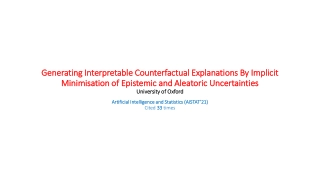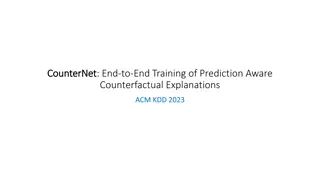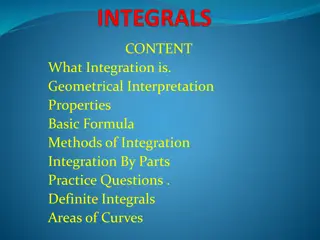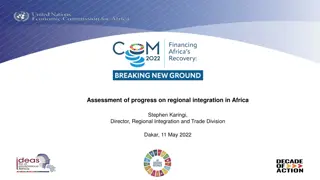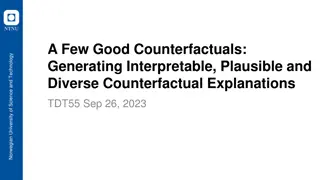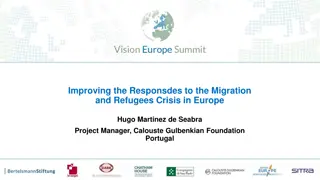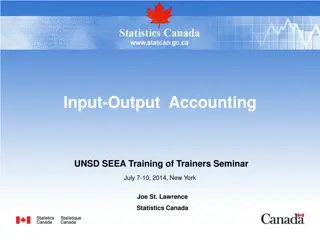Deep Integration and Economic Growth: Counterfactual Analysis in Europe
This study explores the concept of counterfactual analysis in economic growth, particularly focusing on synthetic counterfactuals to understand complex relationships. It discusses the challenges of projecting GDP growth rates over extended periods, providing insights into identifying growth factors and constructing similar country models for analysis.
Download Presentation

Please find below an Image/Link to download the presentation.
The content on the website is provided AS IS for your information and personal use only. It may not be sold, licensed, or shared on other websites without obtaining consent from the author.If you encounter any issues during the download, it is possible that the publisher has removed the file from their server.
You are allowed to download the files provided on this website for personal or commercial use, subject to the condition that they are used lawfully. All files are the property of their respective owners.
The content on the website is provided AS IS for your information and personal use only. It may not be sold, licensed, or shared on other websites without obtaining consent from the author.
E N D
Presentation Transcript
Comments on: Deep integration an Economic Growth: Counterfactual Evidence from Europe (Nauro F. Campos and Fabrizio Coricelli and Luigi Moretti) By Neven Mates Standard disclaimer applies, represents only my views Dubrovnik June 13, 2016
Counterfactual What if We cannot know, this is counterfactual Example: What would be with X had Y not hapend? But this paper suggests that answering this question is easy. It uses Synthetic counterfactuals .
Projecting GDP growth rates over longer periods is not easy (1) Levine (1992): How robust are various variables in projecting GDP growth over longer time? Almost all results are fragile except for investment to GDP ratio. And to a lesser extent, the initial income level.
Projecting GDP growth rates over longer periods is not easy (2) Take a similar country Which hardly exist or construct a new one.
Take 7 growth factors (1) 1. The pre-treatment (year by year) GDP per capita (PPP Converted at 2005 constant prices, rgdpch) 2. The pre-treatment average of the investment share of per capita GDP (PPP Converted at 2005 constant prices, ki) 3. Population growth (popgr), all from Penn World Tables 7.0; 4. Share of agriculture in value added (agr) 5. Share of industry in value added (ind) 6. Secondary gross school enrolment (sec) 7. Tertiary gross school enrolment (ter), all from World Bank.
Take 7 growth factors that would give you a similar country (2) Try to find a combination of weights and select a set of donor , non-EU countries, by which you can via linear combination approximate characteristics (explanatory variables, and the GDP per capita) of countries, in pre-EU period.
2004 1973
2004 1995
Table A.1 Denmark Treated 14,128.42 13,715.86 18.60 0.01 6.47 32.07 20.46 93.01 United Kingdom Treated 13,913.92 13,957.56 14.06 0.01 Ireland Treated 8,184.70 Synthetic deviation (%) -2.9 4.0 2,429.2 75.0 13.6 -6.3 -15.0 Synthetic deviation (%) 0.3 32.3 236.3 Synthetic 8,188.56 22.51 deviation (%) 0.0 20.3 816.3 -42.5 30.8 41.0 -20.3 rgdpch ki popgr agr ind ter sec 19.35 0.18 11.32 36.44 19.18 79.05 18.59 0.02 18.71 0.00 16.31 33.96 11.62 74.38 0.02 9.38 44.41 16.38 59.25 41.55 14.88 75.39 36.12 18.98 75.18 -13.1 27.5 -0.3 Greece Treated 15,438.97 15,445.26 30.69 0.01 Spain Treated 14,801.19 14,780.81 22.62 0.01 8.56 33.63 19.70 76.32 Portugal Treated 9,851.04 Synthetic deviation (%) 0.0 -12.4 110.5 Synthetic deviation (%) -0.1 -12.2 88.6 7.0 12.1 29.2 -8.9 Synthetic 9,839.44 22.86 deviation (%) -0.1 -3.4 243.5 -37.5 22.6 66.0 33.8 rgdpch ki popgr agr ind ter sec 26.88 0.02 19.86 0.02 9.16 37.69 25.46 69.50 23.67 0.01 22.00 30.77 10.58 49.59 0.02 13.75 37.73 17.56 66.35 15.92 74.83 26.01 75.15 63.4 0.4 Austria Treated 25,563.83 25,551.33 22.20 0.00 3.67 33.67 28.22 98.79 Finland Treated 21,584.77 21,599.32 24.06 0.00 7.02 33.99 40.85 108.30 Sweden Treated 24,649.82 24,639.28 17.56 0.00 4.04 30.62 32.59 93.12 Synthetic deviation (%) 0.0 20.1 82.9 -12.0 4.5 4.7 -0.4 Synthetic deviation (%) 0.1 6.2 153.5 107.5 2.1 -18.5 -15.5 Synthetic deviation (%) 0.0 33.9 175.5 105.4 7.4 20.4 -1.6 rgdpch ki popgr agr ind ter sec 26.67 0.01 3.23 35.17 29.55 98.41 25.56 0.01 14.57 34.69 33.28 91.50 23.52 0.01 8.30 32.90 39.23 91.62
Table A.2 Czech Republic Treated 15,261.36 15,245.73 22.17 4.38 39.11 0.00 20.00 91.86 Estonia Treated 7,783.55 Hungary Treated 11,036.94 11,031.31 17.07 7.66 29.89 0.00 21.70 90.97 Synthetic deviation (%) -0.1 77.8 145.0 -5.5 -2,945.8 84.3 -8.1 Synthetic 7,774.22 20.46 10.89 32.54 deviation (%) -0.1 -5.5 99.8 5.2 -118.2 -23.1 -22.7 Synthetic deviation (%) -0.1 24.3 32.1 13.4 -694.4 74.9 -15.1 rgdpch ki agr ind popgr ter sec 39.41 10.73 36.94 0.01 36.86 84.45 21.64 5.45 30.94 -0.02 31.60 97.77 21.21 10.12 33.89 0.01 37.95 77.22 0.00 24.30 75.54 Latvia Treated 6,377.26 Lithuania Treated 7,586.69 Poland Treated 8,928.35 Synthetic 6,368.92 22.70 12.13 32.58 deviation (%) -0.1 86.1 41.5 5.3 -188.3 -29.9 -29.4 Synthetic 7,580.47 19.09 14.80 33.80 deviation (%) -0.1 78.2 24.0 0.0 -810.9 -11.4 -23.7 Synthetic 8,932.19 27.74 10.16 34.61 deviation (%) 0.0 73.9 31.8 -1.4 360.3 -21.5 -20.3 rgdpch ki agr ind popgr ter sec 12.20 8.57 30.95 -0.01 26.21 88.04 10.71 11.94 33.80 0.00 27.87 85.84 15.95 7.71 35.09 0.00 31.52 95.16 0.01 18.37 62.15 0.01 24.69 65.49 0.01 24.75 75.89 Slovak Republic Treated 10,898.34 10,193.11 21.38 5.90 37.00 0.00 18.69 89.36 Slovenia Treated 15,292.52 15,291.48 23.12 4.51 36.91 0.00 31.50 89.73 Synthetic deviation (%) -6.5 39.2 38.5 -2.6 -35.1 90.0 -1.4 Synthetic deviation (%) 0.0 39.2 52.8 0.4 879.2 58.5 2.3 rgdpch ki agr ind popgr ter sec 29.77 8.17 36.02 0.00 35.51 88.14 32.18 6.89 37.07 0.01 49.93 91.78


